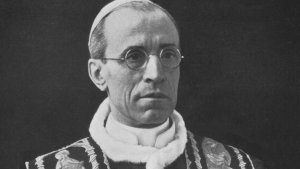During the German pope’s pontificate (2005-2013), the field of astronomy continued to deepen its understanding of the mysteries of black holes. In 2006, the study of a cluster of galaxies provided further proof of the existence of dark matter. Two years later, the first measurement of the angular momentum of a stellar black hole was made. In 2012, the publication of the first images of a supermassive black hole sucking in a red giant made history. It was an impressive photo that would travel around the world.
In the same years, the International Astronomical Union also redefined the notion of planet, demonstrating an ever more precise science, in a constant process of questioning. This is also one of the hallmarks of the intellectual quest of the 265th Pope, who from the moment of his election presented himself as “a simple and humble worker in the Lord’s vineyard.”
Papal Q&A with astronauts
“We all admire your courage,” said Benedict XVI to the 12 International Space Station (ISS) astronauts with whom he spoke for some 20 minutes via satellite audio-video link on May 21, 2011. On this occasion, seated in front of a small desk on Earth, the Pontiff assumed the role of student, acknowledging how “space exploration is a fascinating scientific adventure” and formulating five questions to the scientists.
“In the midst of your intense work and research, do you ever stop and reflect […] perhaps even to say a prayer to the Creator? Or will it be easier for you to think about these things once you have returned to Earth?” Benedict XVI asked, gazing at the screen in front of him. “Believers often look up at the limitless heavens and, meditating on the Creator of it all, they are struck by the mystery of His greatness,” he reflected.
It was also during Benedict XVI’s pontificate, in 2009, that the the Vatican Observatory at Castel Gandolfo inaugurated its new premises. In various speeches to astrophysicists, Joseph Ratzinger spoke about his “wonder,” “joy,” and “respectful admiration” for scientific discoveries, stressing that authentic knowledge must be “always turned towards wisdom” and understood “in all its liberating breadth.”
Benedict XVI and Galileo
“Modern cosmology has shown us that neither we, nor the earth we stand on, are the center of our universe, composed of billions of galaxies, each of which contains myriads of stars and planets,” he added, almost 400 years after the trial of Galileo, condemned by the Church in 1633.
Speaking to astronomers from around the world at a meeting marking the International Year of Astronomy, Benedict XVI openly praised “careful studies which have clarified the precise historical context of Galileo’s condemnation.”
Three months earlier, Archbishop Sergio Pagano, Prefect of the Vatican’s Secret Archives, had presented the Vatican with a new edition of the Acts of the Italian astronomer’s trial. On that occasion, the Holy See Press Office declared that the “Galileo Affair” had taught the Church to approach scientific problems “with great humility and circumspection.”





